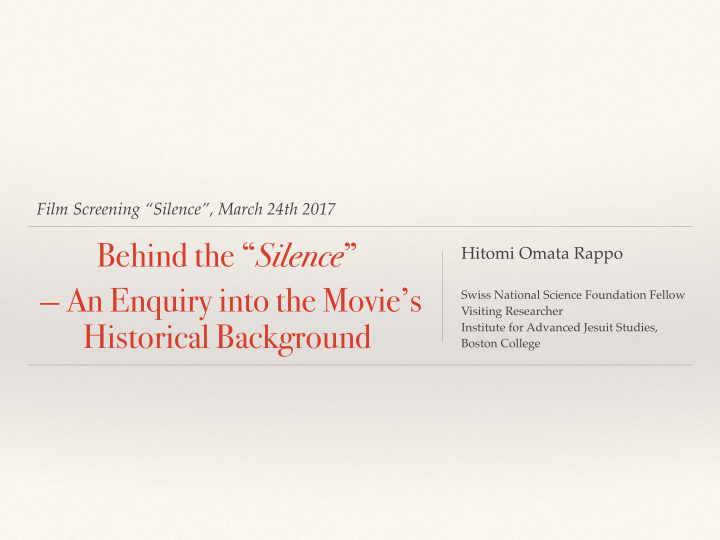



Film Screening “Silence”, March 24th 2017 Behind the “ Silence ” Hitomi Omata Rappo — An Enquiry into the Movie’s Swiss National Science Foundation Fellow Visiting Researcher Historical Background Institute for Advanced Jesuit Studies, Boston College
End ō Sh ū saku (1923-1996) , “ Silence ” ( Chinmoku ), 1966
Christovão Ferreira’s Death as a Martyr (Fake news) Matthias Tanner, Societas Jesu usque ad sanguinis et vitae profusionem militans , 1675 “ First, he apostatized his Christian faith due to his torments. However, after his eightieth anniversary, he had a change of heart. He was then awfully seized because (of his faith) in the Christ and killed, suspended by the feet over a small pit. In Japan, year 1652. ”
Arnoldus Montanus, Confrontation between Atlas Japonnensis … , Cristóvão Ferreira and four Jesuits in 1643. Londres, 1670
沢野忠庵 Lorem Ipsum Dolor Originally in Kodai-ji Temple, Nagasaki. Tomb stone of the Sugimoto Transferred in 1960’s by Ferreira’s descendant to Clan, including Sawano Ch ū an Zuirin-ji (Buddhist temple of School of Nichiren) Tokyo, Yanaka (Alias Cristóvão Ferreira)
Portrait of Giuseppe Chiara (1602-1685), model of Sebastião Rodrigues Portrait as martyr (Fake news again) la Chiesa Madre intitolata a San Nicolò di Bari, Chiusa Sclafani (Palermo), Sicilia “ He died of a particularly awful death, his neck pierced by sharpened bamboo sticks. After a long suffering he returned to the heavens and obtained the glory of martyrdom around the year 1649 .”
Buddhist Gravestone of Giuseppe Chiara Originally in the Tokyo Metropolitan Z ō shigaya Cemetery. Now conserved in the garden of monastery of the Society of Saint Francis de Sales, Ch ō fu, Tokyo.
Summary of Giuseppe oral Extract of the Kirishitoki testimony made by “Inoue- dono” (Inoue Masashige) 契利斯督記
An Example of Ferreira’s Contribution to the Transmission of Western Knowledge (astronomy) in Japan Based on Obara Satoru’s Studies Mateo Ricci Pedro Gomez Qian kun ti yi /Kenkon taigi 乾坤體義 De sphaera, IN: Compendium 1605 1593 Giuseppe Chiara Cristóvão Ferreira Anonymous Book Japanese translation Tenmon biy ō 天文備用 from 1643 in Japan Tenky ū -ron 天球論 translated by 1644 1595 Cristóvão Ferreira ca. 1650 Mukai Gensh ō 向井元升 Nishikawa Joken 西川如見 Kenkon bensetsu 乾坤弁説 Tenmon giron 天文義論 1650 1712
Scene of Fumi-e : Up: Fumi-e, which inspired End ō Sh ū saku in his writing of Silence Depicted in Philipp F. B. von Siebold, Nippon , (1832-1882), Illustrated by Kawahara Keiga Originally conserved at the Nagasaki J ū rokuban-kan museum
Image of Torture in the Hot Springs Arnoldus Montanus, Actual Unzen Hot Springs Gedenkwaerdige Gesantschappen , Major attraction of the town 1669
Anatsurushi: Left: David Bowie in the Anatsurushi torture (a scene from Torture by burying of the body at the bottom of a Merry Christmas, Mr. Lawrence ) Pit (Japanese Scholar Masaharu Anesaki’s study) Right: Matthias Tanner, Societas Torture by Suspension in a Pit (description in the Jesu usque ad sanguinis et vitae western sources) profusionem militans , 1675
As for the torture…. one of the tortures in the film, but not described in the original novel Tawaramaki (Torture by Wrapping the Victim in a Rice Bag Made of Straw) Illustration from Kirishitantaiji monogatari (How the Christians were defeated) , 1665
As for the torture…. one of the tortures actually done toward christian servants Wooden Horse, or the Chevalet Reproduction in the Edo Wonderland (Theme Park), Nikk ō (Typical Torture Device in the A popular photo site for Edo period) instagramers and tourists
Martyrdom of Marcelo Mastrilli Francisco Cardim, Fasciculus e Iapponicis floribus , 1646,
Left: Edict issued by TOYOTOMI Hideyoshi, prohibiting the missionary activities by foreigners Right: Bulletin board, concerning the ban of Christianity, dated 1682 The National Ban of Christianity under the Toyotomi and Tokugawa Regimes
As for the costume …. Actor Asano Tadanobu (Interpreter in film) shaved his own hair for the role in “Silence”. The missionaries were reported to Japanese Male Hair style in the Early modern period is wear contemporary Japanese clothes characterized by Sakayaki 月 and have hair style as upper, according 代 , shaving the center and to the document in Tsukoichiran . upper part of the hair.
Our Lady of the Snows Painting on paper : unknown Japanese painter, Nagasaki, 17th Century
Recommend
More recommend